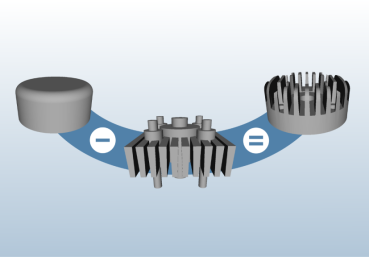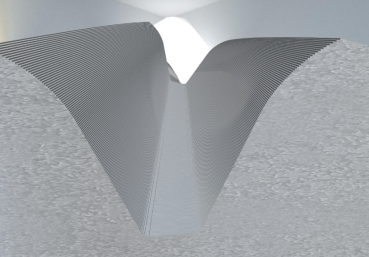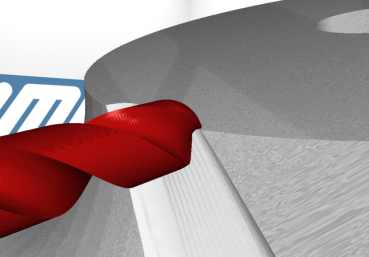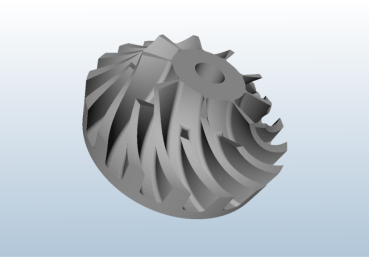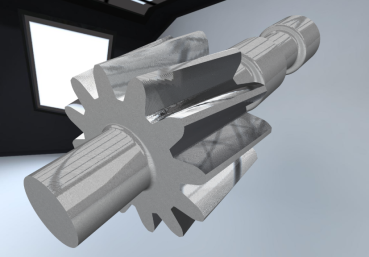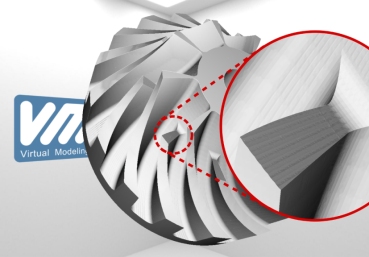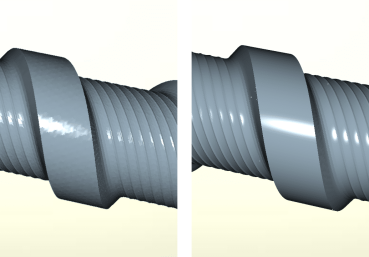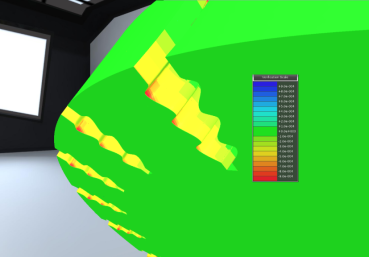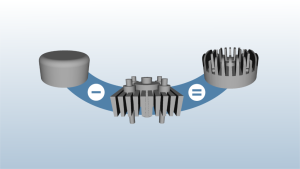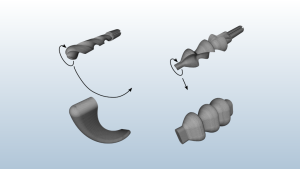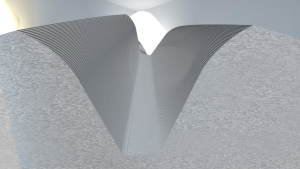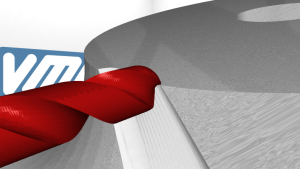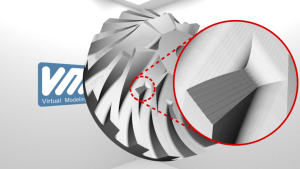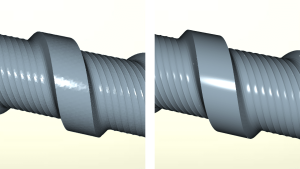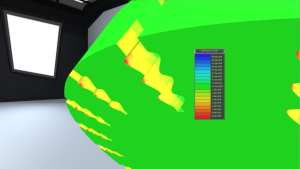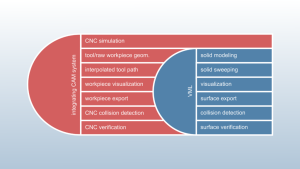Virtual Modeling Library
PRÄZISE MODELLIERUNG VON DETAILIERTEN GEOMETRIEN FÜR ECHTZEITSIMULATIONEN

Die Virtual Modeling Library (VML) ist eine Software Bibliothek, welche neue Algorithmen zur exakten geometrischen Modellierung von Festkörpern implementiert. Sie unterstützt an Constructive Solid Geometry (CSG) angelehnte Operationen und die Hüllvolumenberechnung. Die VML bietet hinsichtlich Laufzeit und Speicherbedarf eine gute Skalierbarkeit bezüglich der Anzahl der bei der Modellierung durchgeführten Operationen. Dadurch ist die Bibliothek bestens für industrielle Anwendungen geeignet, welche kombinierte Anforderungen hinsichtlich geometrischer Genauigkeit und Geschwindigkeit der Operationen aufweisen. Ein Anwendungsbeispiel ist die Echtzeitsimulation des Materialabtrags bei zerspanenden Bearbeitungsprozessen mit einer hohen Anzahl an Bearbeitungsschritten. Neben der Modellierung bietet die VML Algorithmen zur interaktiven Visualisierung, Kollisionserkennung zwischen einer beliebigen Geometrie und der aktuellen Geometrie und Oberflächenverifikation zwischen der aktuellen Geometrie und einem Referenz-CAD-Modell. Um die hohe Laufzeiteffizienz sicherzustellen, nutzt die VML das Parallelisierungspotential moderner Hardware-Architekturen wie Multi-Core Central Processing Units (CPUs) und Graphic Processing Units (GPUs). Neben den bereits erwähnten Produkteigenschaften bietet die VML den Export der Oberfläche der aktuellen Geometrie und die Einfachheit der Integration in andere Softwaresysteme.
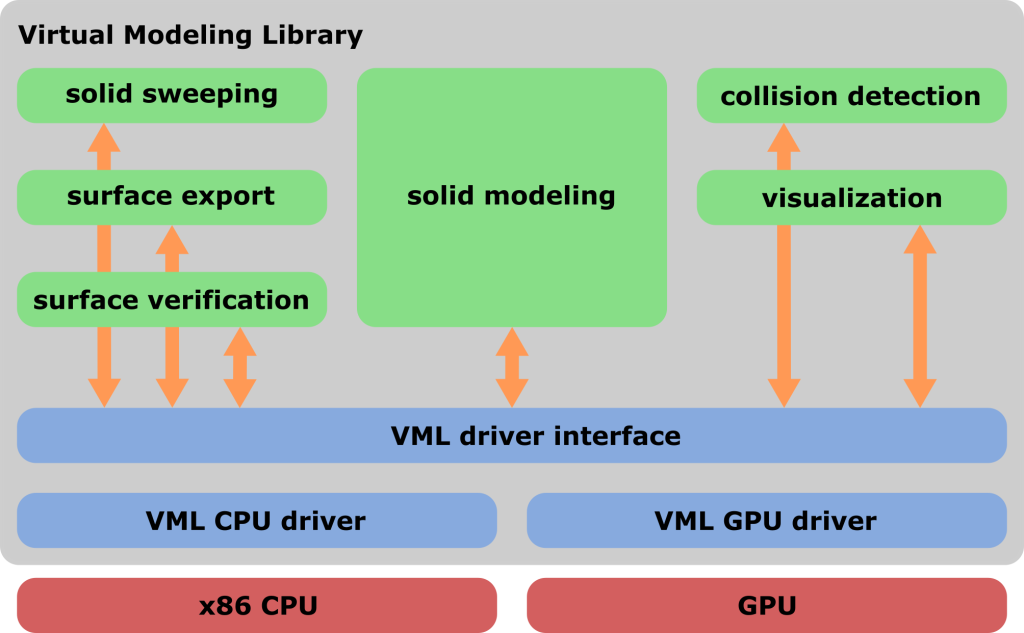
Die Entwicklung wesentlicher Teile der Verfahren, welche die VML implementiert, wurde im Rahmen des Programms Regionale Wettbewerbsfähigkeit OÖ 2007-2013 aus Mitteln des Europäischen Fonds für Regionale Entwicklung sowie aus Mitteln des Landes OÖ gefördert.

Features
Festkörpermodellierung
Die VML unterstützt an Constructive Solid Geometry (CSG) angelehnte Operationen. Dabei müssen die an den Operationen beteiligten geometrischen Objekte in einem geschlossenen Begrenzungsflächenmodell vorliegen. Durch Verwendung einer hierarchischen Raumpartitionierung kombiniert mit einer intelligenten Eliminierungsstrategie, weist die Modellierung eine hohe Speicher- und Laufzeiteffizienz auf.
Hüllvolumenberechnung
Die VML berechnet, basierend auf einem geometrischen Objekt und einem Pfad, das entsprechende Hüllvolumen. Durch die Verwendung eines auf Punktwolken basierten Ansatzes, weist die Berechnung eine herausragende Laufzeiteffizienz auf. Weiters unterliegen das geometrische Objekt und der Pfad keinerlei Einschränkungen.
Hohe Anzahl an Operationen
Die VML unterliegt keinem Limit bezüglich der Anzahl der durchgeführten Operationen während der Modellierung. Aufgrund der intelligenten Eliminierungsstrategie hat das Durchführen auch von 100.000 Operationen nur geringe Auswirkungen auf die Speicher- und Laufzeiteffizienz der VML.
Kollisionserkennung
Die VML erkennt Kollisionen zwischen dem aktuellen geometrischen Modell und einem beliebigen geometrischen Objekt. Der Kollisionserkennungsalgorithmus ist auch in der Lage einen definierten Mindestabstand zu berücksichtigen. Durch Verwendung einer hierarchischen Raumpartitionierung, können Kollisionen innerhalb von Millisekunden erkannt werden.
Oberflächen Export
Die VML exportiert die Oberfläche des aktuellen geometrischen Modells in Form eines Dreiecksnetzes mit einer definierten Auflösung. Dabei bleiben geometrische Eigenschaften wie Kanten und Ecken erhalten.
Interaktive Visualisierung
Um das aktuelle geometrische Modell bei interaktiven Bildraten zu visualisieren, liefert die VML eine Repräsentierung in Form eines Dreiecksnetzes. Mit etablierten Technologien wie OpenGL oder DirectX werden fotorealistische Visualisierungen erzielt.
Hohe Genauigkeit
Duale geometrische Repräsentierung
Die VML untersützt zur geometrischen Beschreibung von Oberflächen zwei unterschiedliche Repräsentierungen. Dreiecksnetze bieten eine hohe Verarbeitungsgeschwindigkeit bei mittlerer geometrischer Genauigkeit. Analytische Oberflächen hingegen erlauben eine hohe Präzision mit minimalen Abstrichen in der Performanz.
Oberflächenverifikation
Die VML vergleicht die Oberfläche des aktuellen geometrischen Modells mit einem Referenz-CAD-Modell. Die Berechnung der Differenzwerte für beliebige Ansichten ist bei interaktiven Bildraten möglich. Der Differenzwert ist der Normalabstand von einem Punkt auf der aktuellen Oberfläche zu der Referenz Oberfläche.
Einfache Integration
Die VML hat eine sehr kompakte Schnittstelle. Ein CAM System kann basierend auf der VML eine Bearbeitungssimulation umsetzen. Dabei verwendet es die VML Module zur Hüllvolumenberechnung und Festkörpermodellierung um die Simulation des Materialabtrags durchzuführen. Die Module zur Kollisionserkennung und Oberflächenverifikation werden für die CNC Verfifikation verwendet.
Ansprechperson

Dipl.-Ing. (FH) Alexander Leutgeb
Head of Unit Industrial Software Applications
